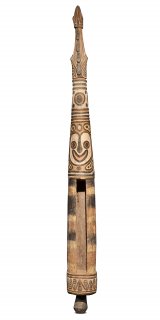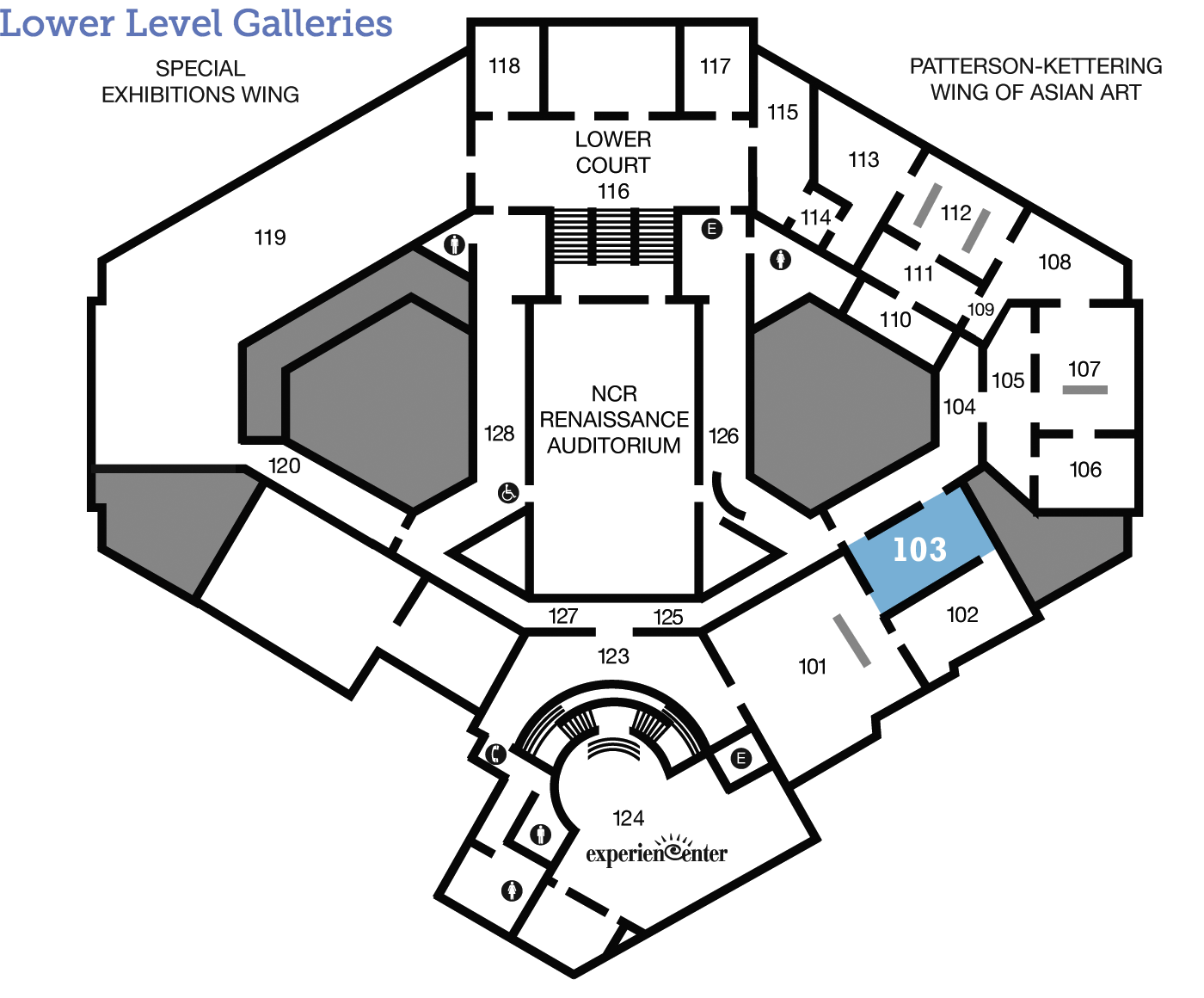
Wogumas People
Slit Drum
Melanesian Wood, pigment 101 x 10 x 10 inches (256.5 x 25.4 x25.4 cm) April River area, Upper Sepik River, Papua New Guinea, Melanesia, Asia Gift of Donald and Sue Dugan in memory of Douglas Newton 2008.5
A Musical Instrument as a Sacred Object
Do you play a musical instrument? Would you be surprised if the sound it makes is the voice of a spirit? Learn more about the power of sound with this slit drum from the Wogumas people in the island country of Papua New Guinea.
A Day in the Life
An Essential Part of the Community
Slit drums—hollowed logs with a long, vertical opening for the sound—are important musical instruments for many of the traditional communities throughout Papua New Guinea. They are stored in the communal men’s society house and played during special ceremonies, such as those related to society initiations and warfare. Look at the face in the center of this drum; does it look male or female to you? It is believed to represent a female water spirit and the sound of the drum is the spirit’s voice. Ironically, women are not permitted to play the drums, and particularly special ones are even kept out of sight from women and children.
Slit drums may also serve as a long-distance communication device. In a manner similar to Morse code, drummed messages provide a way to instantly contact community members that are away from the village. You can hear the sound of a slit drum in the audio clip below.
Tools and Techniques
Behind the Scenes
Look Closer
Just for Kids
Create!
This might not look like the average drum; this drum is from Papua New Guinea, off the coast of Australia. It is played during special celebrations. Listen to a slit drum here:
At what kind of event do you think this drum is played? Why?
Have you ever drawn while listening to music before? At home, play the music again. This time listen to the rhythm of the drum. With colored pencils or markers draw what you feel or what the music reminds you of. Play the music a couple of times until you finish. Then, look at your completed artwork. What kind of lines, colors, shapes, and textures did you create? Were you able to express how the music made you feel when you were drawing? Why or why not?
Signs & Symbols
Dig Deeper
Arts Intersected
Listening to Art
This slit drum is both a musical instrument and a work of visual art. Look closer at the designs on the surface and note how these create different rhythmic effects by repeating forms that lead your eye in certain movements. Pattern and rhythm are also important in music. Listen to the sound of a slit drum in the audio clip below and continue looking at the design patterns on this drum. Consider if hearing the rhythmic sounds changes the way you see the visual rhythms.
The Sculpture Speaks
Did You Know?
Limited Information
The Wogumasin culture is comprised of four groups of people each living in their own village in the Upper Sepik region of northeast Papua New Guinea. They share a common language, Wogumas. Little is known about the early history of their villages. The main village, Wogumas, was burned by the Japanese during World War II. Art from the area is rare, but enough is known of the culture to say that their most important works relate to music and to the river.
Further Reading: Douglas Newton, Crocodile and Cassowary: Religious Art of the Upper Sepik River, New Guinea (New York: The Museum of Primitive Art, 1971).
Expert Opinion
Look Around
Musical Animals
People from Papua New Guinea are not the only ones who have used slit drums, hollowed logs with a long, narrow opening for the sound. Look at the Slit Drum in the Form of a Buffalo by the Lobala people in the African Gallery, Gallery 101.
Do you notice any similarities between the two instruments? Both integrate stylized animal forms into the structure of the drum. In the one by the Lobala people it is a water buffalo. In the one by the Wogumas people it is a crocodile, which appears on the tapered end. As you explore the Oceanic and African Galleries, look for other ways animals appear in different artworks.
About the Artist
Talk Back
Function Versus Form
For the Wogumas people in Papua New Guinea, many artworks take the form of a musical instrument and serve a practical purpose. Will your experience of this object be incomplete since you cannot see it in use? What unique experience may come from focusing on its visual form apart from hearing it?

